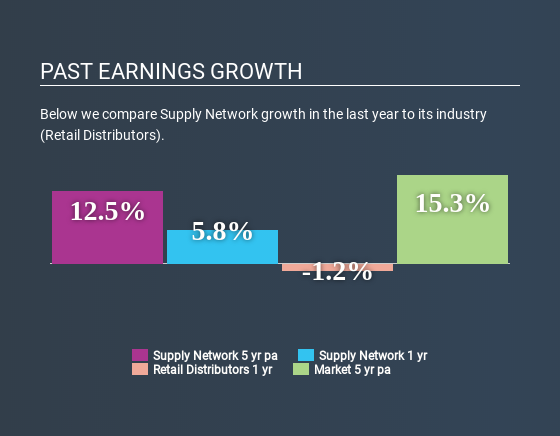Supply Network Limited's (ASX:SNL) Stock On An Uptrend: Could Fundamentals Be Driving The Momentum?

Supply Network (ASX:SNL) has had a great run on the share market with its stock up by a significant 26% over the last three months. We wonder if and what role the company's financials play in that price change as a company's long-term fundamentals usually dictate market outcomes. In this article, we decided to focus on Supply Network's ROE.
ROE or return on equity is a useful tool to assess how effectively a company can generate returns on the investment it received from its shareholders. In other words, it is a profitability ratio which measures the rate of return on the capital provided by the company's shareholders.
View our latest analysis for Supply Network
How To Calculate Return On Equity?
The formula for return on equity is:
Return on Equity = Net Profit (from continuing operations) ÷ Shareholders' Equity
So, based on the above formula, the ROE for Supply Network is:
22% = AU$9.0m ÷ AU$40m (Based on the trailing twelve months to December 2019).
The 'return' is the income the business earned over the last year. So, this means that for every A$1 of its shareholder's investments, the company generates a profit of A$0.22.
What Is The Relationship Between ROE And Earnings Growth?
We have already established that ROE serves as an efficient profit-generating gauge for a company's future earnings. Based on how much of its profits the company chooses to reinvest or "retain", we are then able to evaluate a company's future ability to generate profits. Assuming everything else remains unchanged, the higher the ROE and profit retention, the higher the growth rate of a company compared to companies that don't necessarily bear these characteristics.
Supply Network's Earnings Growth And 22% ROE
To begin with, Supply Network has a pretty high ROE which is interesting. Second, a comparison with the average ROE reported by the industry of 6.0% also doesn't go unnoticed by us. Probably as a result of this, Supply Network was able to see a decent net income growth of 13% over the last five years.
We then compared Supply Network's net income growth with the industry and found that the company's growth figure is lower than the average industry growth rate of 17% in the same period, which is a bit concerning.
The basis for attaching value to a company is, to a great extent, tied to its earnings growth. The investor should try to establish if the expected growth or decline in earnings, whichever the case may be, is priced in. By doing so, they will have an idea if the stock is headed into clear blue waters or if swampy waters await. Is Supply Network fairly valued compared to other companies? These 3 valuation measures might help you decide.
Is Supply Network Using Its Retained Earnings Effectively?
The high three-year median payout ratio of 67% (or a retention ratio of 33%) for Supply Network suggests that the company's growth wasn't really hampered despite it returning most of its income to its shareholders.
Moreover, Supply Network is determined to keep sharing its profits with shareholders which we infer from its long history of paying a dividend for at least ten years.
Summary
In total, it does look like Supply Network has some positive aspects to its business. Its earnings have grown respectably as we saw earlier, which was likely due to the company reinvesting its earnings at a pretty high rate of return. However, given the high ROE, we do think that the company is reinvesting a small portion of its profits. This could likely be preventing the company from growing to its full extent. Up till now, we've only made a short study of the company's growth data. So it may be worth checking this free detailed graph of Supply Network's past earnings, as well as revenue and cash flows to get a deeper insight into the company's performance.
This article by Simply Wall St is general in nature. It does not constitute a recommendation to buy or sell any stock, and does not take account of your objectives, or your financial situation. We aim to bring you long-term focused analysis driven by fundamental data. Note that our analysis may not factor in the latest price-sensitive company announcements or qualitative material. Simply Wall St has no position in any stocks mentioned.
Have feedback on this article? Concerned about the content? Get in touch with us directly. Alternatively, email editorial-team@simplywallst.com.

